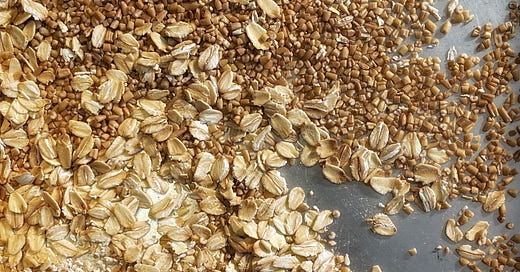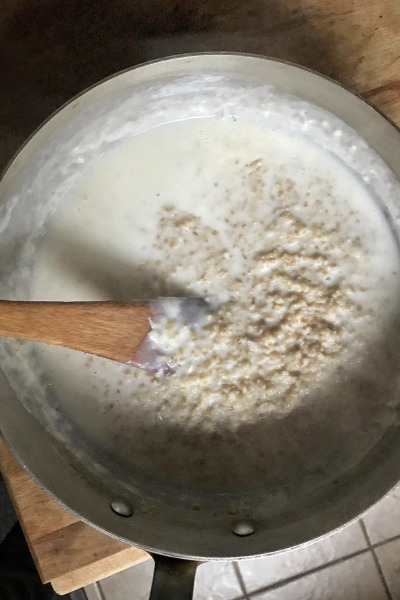The Science of Oats
A Q&A with food researcher Swetha Sivakumar, plus exciting news in Veggie Burger Land
There’s lot happening in this dispatch — news on the veggie burger front; a few links I’ve been collecting; and an enlightening, #28daysofoatmeal q&a with food researcher Swetha Sivakumar.
I’m delighted to share that my first cookbook Veggie Burgers Every Which Way is being reissued in a sparkling new hardcover edition! I’ve had some time over the past year and a half to sit with these pages, add new recipes, incorporate the veggie burger tricks I’ve learned over the past 13+ years, and to witness new photographs and a beautiful new design coming together — and it’s been a great deal of fun.
For fans of Made by Lukas, the veggie burger business I created and ran for about 4 years, I’m pleased to share that you can find those those recipes in these pages, too, for the first time ever. It’s available for preorder now and all of us — my publisher, myself, and all the booksellers — are deeply appreciative if you’re willing to show your early support!
And quickly, a few links I enjoyed and have been meaning to share:
How to Get a Job as a Food Stylist, work that is “as much about preparedness as it is creativity.”
Recipes for the Road — Heidi Swanson’s homemade dry mixes for camping cooking.
Artichoke Melts, these sound delicious.
When Did Hospitality Get So Hostile? “The ancient mandate of hospitality rests in part on pragmatism: We were historically taught to give comfort to strangers because we might one day be strangers ourselves.”
You Should Be Saving Your Rice Water — bean broth, pasta water, and now rice water? All liquid gold of a sort.
The Science of Oats, with Swetha Sivakumar
I’ve been following Austin-based food researcher Swetha Sivakumar’s work on her blog Upgrade My Food for a little while now. Guided by her background in science and industrial engineering, as well as her persistent curiosity about the why of food, I’m always learning something new or finding a surprising way to rethink something I thought I already knew. And as someone who does not have a science background — and in fact is alway struggling to retain scientific information — I find her explanations straightforward and accessible, and that most of the time they even stick! Swetha has done some research about oats and why they’re such a special member of of cereal grain family, and I thought that a brief chat with her would be a good opportunity to learn a bit more about them.
First off, could you tell me a bit about your background, and how you came to become a food researcher?
I have always been interested in the “whys” of cooking more than the “hows.” I have never been a person who followed recipes to the T or did something just because my mom and grandma did it. I always wanted to know the “why.” My background in Industrial Engineering may have also helped me with this thought process. Learning about food science makes me more confident in the kitchen. Any ingredient—be it oats or lentils or spices, I want to know why it behaves the way it does. So, I experiment with ingredients and write about it.
What is it about oats that make them stand out from other grains?
The oats grain, luckily for us, does not break cleanly into endosperm, germ, and bran like rice or wheat. For example, in rice—you have white rice and brown rice. In wheat—you have refined flour and whole wheat flour. But, have you ever heard of white oats and brown oats? Most likely not. It is because in oats, the grain is softer and does not break cleanly into distinct parts. In other grains, most of the valuable nutrients are in the outer layers of the grain which gets polished off. In oats, whether it is rolled or steel cut or instant, they carry all parts of the grain.
So rolled, quick-cooking, steel-cut, whole groats — they’re all the whole grain.
Again, oats have some really unique characteristics. They have a higher fat content of 6–8% compared to most cereal grains, which have 2–3% fat. But, they also carry an enzyme called lipase in a separate compartment in the grain. When the manufacturers remove the husk, the compartment is destroyed, causing the enzyme to react with the fats. This could cause rancidity in the grain unless it is heat treated. So, all types of oats, from groats to instant, have to undergo steam treatment in a kiln to deactivate the enzyme. The kilning however has added benefits of providing a nutty flavor and killing any bacteria or molds thereby increasing safety and quality.
Could you explain the different product classifications — rolled, steel-cut, quick cooking?
Oat groats, or whole oats, are the intact grain kernel post-kilning.
Steel-cut oats are groats which have been chopped into two or three pinhead-sized pieces (hence the names; “steel-cut” comes from the steel blades).
Rolled oats are basically oat groats that have been steamed and flattened between 0.51–0.76 mm. Quick oats are rolled even thinner 0.36–0.46 mm. Since rolled oats and quick cooking oats are steamed and flattened, some of the starch becomes partially pre-gelatinized; which enables it to absorb water and cook quickly.
Oats flour is made by powdering groats. The coarse parts of the flour are sifted out to become oat bran.
In your recipes, you often soak steel-cut oats first — why is that?
Soaking steel-cut oats decreases the pressure cooking time immensely. It also hydrates and plumps up the grain uniformly.
And you have lots of exciting ideas for savory oats in Indian recipes, like oats khichdi and yogurt rice. Why do steel-cut oats work so well in these treatments?
I come from the Southern part of India. In that part, we have a tendency to cook rice to a more gooey-porridgy state. Comparatively, in the north part of the country, they use Basmati and prefer the grain to stay separate from one another. The gooey texture of oats is perfect for these recipes along with the added benefit of additional fiber (10% compared to 3%).
Oats also beat rice in almost every nutrition metric — protein, Calcium, Iron, Magnesium, Phosphorous, Zinc, Folate. Looking at the impressive numbers, it just makes sense to switch to oats wherever possible. The taste is delicious, too. I love savory oats!
Follow Swetha’s work on her blog Upgrade My Food, Instagram, and Twitter.
And once more, just for reference:







What exciting news! Can’t wait to get the new edition of VBEWW 👍